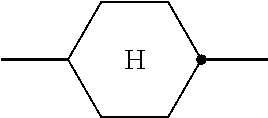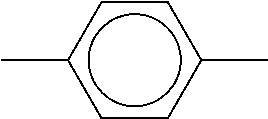Liquid crystal media comprising polymerisable compounds
a technology of liquid crystal media and polymerisable compounds, which is applied in the direction of liquid crystal compositions, chemistry apparatuses and processes, instruments, etc., can solve the problems of reducing the transparency of light, reducing the transparency of tn lcds, etc., to achieve fast and complete uv-photopolymerisation reaction, suitable and stable pretilt angle, and convenient generation
- Summary
- Abstract
- Description
- Claims
- Application Information
AI Technical Summary
Benefits of technology
Problems solved by technology
Method used
Image
Examples
example 1
able Compounds
[0591]Polymerisable compound (or “RM”) RM-1 is prepared as follows
[0592]
[0593]1.4: A suspension of sodium hydride (5.4 g, 60% in mineral oil, 135.6 mmol) was added to a stirred solution of benzyl alcohol 1.3 (20.0 g, 113.0 mmol) in THF (20 mL) at 0° C. The resulting mixture was stirred for 10 min at the same temperature before it was treated with methyl iodide (8.7 mL, 135.6 mmol). The reaction mixture was stirred for 4 hours at ambient temperature, carefully quenched with water and extracted with ethyl acetate. Aqueous phase was separated and extracted with ethyl acetate (2 times). The combined organic phase was washed with sat. NaCl solution, dried over Na2SO4, filtered and concentrated in vacuo. The residue was purified with flash chromatography (heptane) to give 1.4 as a colorless oil. (21.0 g, 97%; GC: 99.9%).
[0594]
[0595]1.6: Hydrazine hydrate (0.2 mL, 80%, 0.004 mol) was added to a stirred solution of sodium metaborate tetrahydrate (43.3 g, 0.314 mol) and PdCl2[P...
example 2
[0602]
[0603]RM-2: Melting Point: 117° C. 1H NMR (CDCl3): δ 7.76 (d, J=2.3 Hz, 1H), 7.72-7.66 (m, 6H), 7.62 (dd, J=8.3, 2.4 Hz, 1H), 7.27-7.22 (m, 3H), 6.42 (dt, J=8.0, 1.2 Hz, 2H), 5.82 (dp, J=7.9, 1.6 Hz, 2H), 4.51 (s, 2H), 3.43 (s, 3H), 2.13 (t, J=1.2 Hz, 3H), 2.12 (t, J=1.3 Hz, 3H). EI-MS: 442.2
example 3
[0604]
[0605]RM-3: Melting Point: 74° C. 1H NMR (CDCl3): δ 7.69 (d, J=2.3 Hz, 1H), 7.65-7.61 (m, 2H), 7.55 (dd, J=8.3, 2.4 Hz, 1H), 7.26-7.19 (m, 3H), 6.41 (dt, J=8.3, 1.2 Hz, 2H), 5.81 (dt, J=8.3, 1.6 Hz, 2H), 4.49 (s, 2H), 3.42 (s, 3H), 2.12 (t, J=1.3 Hz, 3H), 2.11 (t, J=1.2 Hz, 3H). EI-MS: 366.0
PUM
| Property | Measurement | Unit |
|---|---|---|
| tilt angle | aaaaa | aaaaa |
| tilt angle | aaaaa | aaaaa |
| wavelengths | aaaaa | aaaaa |
Abstract
Description
Claims
Application Information
 Login to View More
Login to View More - R&D
- Intellectual Property
- Life Sciences
- Materials
- Tech Scout
- Unparalleled Data Quality
- Higher Quality Content
- 60% Fewer Hallucinations
Browse by: Latest US Patents, China's latest patents, Technical Efficacy Thesaurus, Application Domain, Technology Topic, Popular Technical Reports.
© 2025 PatSnap. All rights reserved.Legal|Privacy policy|Modern Slavery Act Transparency Statement|Sitemap|About US| Contact US: help@patsnap.com



